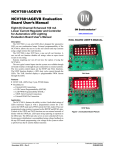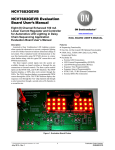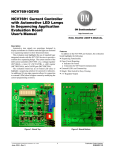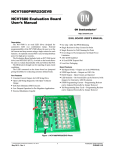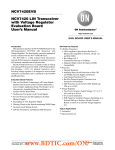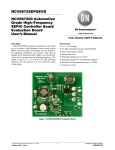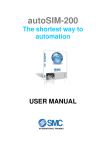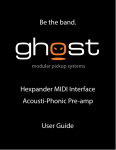Download EVBUM2323 - NCV7681LGEVB Evaluation Board User`s Manual
Transcript
NCV7681LGEVB NCV7681LGEVB Evaluation Board User'sManual Eight (8) Channel Enhanced 100 mA Linear Current Regulator and Controller for Automotive LED Lighting Evaluation Board User’s Manual www.onsemi.com EVAL BOARD USER’S MANUAL Description The NCV7681L is an octal LED driver designed for automotive LED car rear combination lamps. External programmability of the NCV7681L allows the user to set the tail current and stop currents using a single resistor for each function. A one-out all-out function disable all strings when an open circuit occurs on one string. Systems not requiring one-out all-out have the option of using the NCV7681A. The two typical control inputs into the system are available through on-board switches or through the pin connections to external controls. The two system control inputs are the STOP and TAIL functions. The STOP function displays a 100% duty cycle current through the LEDs. The TAIL function displays a programmable PWM current through the LEDs. TAIL Mode Features • One Out, All Out (Latch Off) Optional Functionality • STOP, TAIL (100% Duty Cycle, PWM) Modes • Flexibility for ♦ ♦ ♦ ♦ ♦ External LED Connections LED Current Programmability (RSTOP) LED PWM Programmability (RTAIL) STOP, TAIL External Connections External DIAG Pin Connection Application The NCV7681L features the ability to drive 8 individual strings of LEDs (reference Figure 2) with a programmed current for a DC current for STOP mode and a PWM current for TAIL model. These are programmed using resistors to ground on the RSTOP and RTAIL pins. Control of the STOP and TAIL functions use an external network of diodes with the STOP pin. LED open string reporting is reported on the DIAG pin. The DIAG pin also serves to reset a latched off event. System power distribution is accomplished using voltage feedback on the top LED anode programming a set voltage in the system to allow a split between the IC and the ballast transistor. © Semiconductor Components Industries, LLC, 2015 October, 2015 − Rev. 0 1 STOP Mode Figure 1. Evaluation Board Picture Publication Order Number: EVBUM2323/D NCV7681LGEVB Voltage Regulation Feedback Ballast Transistor LED Loads String 2 String 1 Ballast VP Drive STOP/TAIL Selection & Activation VBAT DIAG RSTOP RTAIL Current Programming String 4 String 5 String 6 String 7 String 8 OUT2 OUT3 OUT4 OUT5 OUT6 OUT7 OUT8 FB STOP Open Circuit Reporting and Reset String 3 OUT1 GND NCV7681 Figure 2. Focus Demonstration STOP TAIL The STOP function displays the highest system output current at 100% duty cycle. Using the STOP switch activates this function. The current is programmable with a resistor on the RSTOP pin to ground. Jumper J3 provides isolation of pin 7 of the NCV7681 allowing access to the pin for alterative selection of output current. The range of programmability is from 15 mA to 100 mA using the equation: The TAIL function displays a lower equivalent output current in the system. This provides a lower illumination of the LEDs. This is achieved with a varied duty cycle of the output current. The duty cycle is programmable with a resistor on the RTAIL pin to ground. Jumper J4 provides isolation of pin 6 of the NCV7681L allowing access to the pin for alternative selection of output duty cycle current. The range of programmability is from 0% duty cycle to 100% duty cycle using the equation: I OUT + 150 RSTOP RTAIL + 1.8 where DC = duty cycle expressed in fractional form. 100 100 90 90 80 80 70 DUTY CYCLE (%) IOUT OUTPUT CURRENT (mA) where RSTOP is the resistor value. RSTOP (DC)0.22) 60 50 40 30 20 70 60 50 40 30 20 10 0 T = 25°C 0 1 2 3 4 5 6 7 8 9 10 0 10 0 RSTOP (kW) 1 2 3 4 5 RTAIL (kW) Figure 4. Duty Cycle vs. RTAIL Figure 3. IOUT vs. RSTOP www.onsemi.com 2 6 7 NCV7681LGEVB Latch Off (“One-Out, All-Out”) To use external LEDs, 1. Remove J14 or J18 depending on your setup 2. Replace with the Anode of your external LED string (connect to the post on the right). 3. If needed, connect the post on the left also with the anode of your external LED string. 4. Remove your selection of J6−J13 (OUTx,y). 5. Connect the Cathode of your external LED string (connect to the post on the right). To improve user aesthetics, the system design utilizes the Latch Off function. All outputs will become latched off when any one of the 8 outputs experiences an open circuit condition. This is defined (at 50 mA) in the electrical parameter “Open Circuit Detection Threshold” and has limits between 35% and 65% of the output current. DIAG RESET switch SW3 provides a system refresh by temporarily grounding the DIAG pin. DIAG The operation of the NCV7681L evaluation board works as a standalone presentation for the customer. Jumpers are provided for flexibility of customer specific designs with external LEDs and programming of the current and duty cycle. External control points are also provided in addition to the on-board control switches. The user must adhere to the absolute maximum ratings when using off-board connections. Note the inclusion of the Open Load Disable Threshold in the NCV7681L device. This is included to avoid false open load detection at low supply voltages due to headroom issues with external LEDs. Operation of LED drive current is valid above the Output Under Voltage Lockout threshold (VP = 4.1 V [typ]), allowing for illumination down to that voltage, but open load detection is only valid above VP = 7.7 V [typ]. The DIAG pin of the NCV7681L provides system feedback for conditions: 1. Output open circuit. 2. Set Back Current Limit down 20%. 3. Thermal shutdown. 4. RSTOP Current Limit. An LED indicator with a current setting resistor provides illumination of these conditions. Jumper J5 provides access to these pins for the user to use off-board. External LEDs The NCV7681LGEVB is compatible for use with external LEDs. Table 1. ABSOLUTE MAXIMUM RATINGS Value Unit Supply Voltage to board (VBAT) Rating −40 to 40 V STOP, TAIL −40 to 40 V 200 mA Output Pin Voltage (OUT1−OUT8) −0.3 to 40 V Output Pin Voltage (RTAIL, RSTOP) −0.3 to 3.6 V DIAG −0.3 to 40 V VSTRING −0.3 to 40 V Junction Temperature (NCV7681L) −40 to 150 °C Junction Temperature (Evaluation Board) −40 to 105 °C LED Current Source (OUT1−OUT8) Stresses exceeding those listed in the Maximum Ratings table may damage the device. If any of these limits are exceeded, device functionality should not be assumed, damage may occur and reliability may be affected. Table 2. RECOMMENDED BOARD OPERATING CONDITIONS Value Rating External Supply Voltage (VBAT) LED Current Source Junction Temperature (NCV7681L) Min Max Unit − 28 V − 200 mA −40 150 °C Functional operation above the stresses listed in the Recommended Operating Ranges is not implied. Extended exposure to stresses beyond the Recommended Operating Ranges limits may affect device reliability. www.onsemi.com 3 NCV7681LGEVB Table 3. PIN FUNCTION DESCRIPTION Connector Power Pin Number Terminal Name Description J1, VBAT VBAT Power Supply Input Voltage (14 V) J2, GND GND Ground J3 RSTOP Programmable DC Current J4 RTAIL Programmable Duty Cycle J5 DIAG DIAG Open Drain Output and Open Circuit Reset Input J6 J7 J8 J9 J10 J11 J12 J13 OUT1 OUT2 OUT3 OUT4 OUT5 OUT6 OUT7 OUT8 Current Outputs J14 BALLAST IN J15 J15 Connection to Top of the FB Resistor Network or Open Circuit J16 J16 Connection to Short FB Pin to Ground or Open Circuit J17 J17 Connection for Ballast Drive Gate Pin to Ballast Gate or to Ground J18 BALLAST OUT Connect when Using External Ballast Transistor. Connects Drain of External Ballast Transistor to VSTRING. Connect when Not Using External Ballast Transistor. Shorts S-D of External Transistor. User Interface Locations This lists all the user options available on the evaluation board. Figure 5 shows all the user interface locations. Figure 5. User Interface Locations Black − STOP, TAIL external connections. Grey – STOP, TAIL switches. Dark Blue (2) – STOP programming jumper. Red (2) – TAIL programming jumper + post. Dark Green – VP post. Purple (2) – VSTRING post. Light Blue (4) – OUT1−OUT8 open circuit jumpers. Orange − OUT1−OUT8 output posts. Yellow – Ballast Transistor Selection (2 yellow boxes). Light Green – DIAG RESET. Bright Red – DIAG jumper / post. Brown – Feedback post (FB). www.onsemi.com 4 NCV7681LGEVB OPERATIONAL GUIDELINES Change the Duty Cycle Change the duty cycle programming resistor. Reference the TAIL section. The material necessary to successfully use the evaluation board is listed below. • NCV7683 Evaluation Board • 14 V Power Supply Capable of drive 1 A. Latch Off After creating an open circuit and replacing all open circuit jumpers (OUT6−OUT8), press the DIAG RESET switch. Configure the Board Typical Board Configuration with On-Board Components 1. Connect all jumpers on the board with the exception of Jumper 18. J15−J17 should be to the left. 2. Connect the 14 V power supply. 3. Turn on the power supply. DIAG The on-board LED will illuminate when DIAG reports a fault. Reporting can be taken off-board after removing the DIAG jumper (J5). Increasing the LED Current Change the current programming resistor. Reference the STOP section. Use External LEDs Reference the External LEDs section for instructions. SCHEMATIC 2 J18 1 TAIL J1 Vbat Vstring VP 1 NTD2955 U2 SW1 D25 TAIL MRA4003 R5 1K STOP D26 STOP MRA4003 J15 3 2 1 SW2 2 J14 1 J2 GND R4 9.53K FB 1 3 2 1 J17 J16 R8 4.99K 1 2 3 R7 1K R1 10K R6 10K D27 led_diode D22 D23 D24 led_diode D19 led_diode D20 led_diode D21 led_diode D16 led_diode D17 led_diode D18 led_diode D13 led_diode D14 led_diode D15 led_diode D10 led_diode D11 led_diode D12 2 J13 1 3 OUT1 R2 3.01K J5 1 2 J3 1 2 J4 1 R3 1.62K OUT1 VP Blst FB STOP OUT2 OUT3 OUT4 GND OUT5 DIAG OUT6 RSTOP OUT7 RTAIL OUT8 17 DIAG 2 1 2 3 4 5 6 7 8 16 15 14 13 12 11 10 9 2 J12 1 OUT2 2 J11 1 OUT3 epad 2 J10 1 OUT4 GND GND GND GND SW3 DIAG RESET OUT5 1 J9 2 1 J8 2 OUT6 1 J7 OUT8 Figure 6. Evaluation Board Schematic www.onsemi.com 5 J6 led_diode D7 D8 led_diode D9 led_diode led_diode led_diode D4 D5 D6 led_diode led_diode led_diode 2 OUT7 1 led_diode D1 D2 D3 led_diode led_diode led_diode 2 C1 100nF NCV7681LGEVB BILL OF MATERIALS Table 4. NCV7681L LATCH OFF EVALUATION BOARD BILL OF MATERIALS Designator Qty Description Value Tolerance Footprint Manufacturer Manufacturer Part Number Substitution Allowed C1 1 LED Storage Capacitor 100 nF 10% 0805 KEMET C0805C104K5RACTU Yes C2 1 Debounce Capacitor 10 nF 10% 0805 KEMET C0805C103K5RACTU Yes C3 1 Input Capacitor 0.68 mF 10% 0805 KEMET C0805C684K5RACTU Yes C4 1 Loop Stabilization Capacitor 0.22 mF 10% 0805 KEMET C0805C224K5RACTU Yes D1−D24 24 Display LEDs led_diode − G6SP OSRAM LRG6SP−CADB−1−1 Yes D25−D26 2 Steering Diode MRA4003 − SMA_DIODE ON SEMICONDUCTOR MRA4003T3G Yes D27 1 DIAG Reporting LED led_diode − 0805 LITE−ON INC LTST−C171GKT Yes J3−J14, J18 13 Dual Jumper Posts 100 mil spacing JUMPER − JMP 3M 961102−6404−AR Yes J15−J17 3 Triple Jumper Posts 100 mil spacing JUMPER − JMP 3M 961102−6404−AR Yes J3−J18 16 Jumper − − N/A SULLINS CONNECTOR SOLUTIONS QPC02SXGN−RC Yes J1 1 Banana Jack VBAT − BANANA CINCH CONNECTIVITY SOLUTIONS 108−0740−001 Yes J2 1 Banana Jack GND − BANANA CINCH CONNECTIVITY SOLUTIONS 108−0740−001 Yes Q2 1 DIAG Illumination Transistor Switch 2N7002W − SOT23M4 ON SEMICONDUCTOR ONC 2N7002WT1G/BKN Yes R1, R6 2 Logic Resistors 10 kW 1% 0805 VISHAY DALE CRCW080510K0FKEA Yes R2 1 RSTOP Program Resistor 3.01 kW 1% 0805 VISHAY DALE CRCW08053K01FKEA Yes R3 1 RTAIL Program Resistor 1.62 kW 1% 0805 VISHAY DALE CRCW08051K62FKEA Yes R4 1 Vstring Program Resistor 9.53 kW 1% 0805 VISHAY DALE CRCW08059K53FKEA Yes R5 1 Gate−source Resistor 1 kW 1% 0805 VISHAY DALE CRCW08051K00FKEA Yes R7 1 Vstring Program Resistor 1 kW 1% 0805 VISHAY DALE CRCW08051K00FKEA Yes R8 1 DIAG LED Current Setting Resistor 4.99 kW 1% 0805 VISHAY DALE CRCW08054K99FKEA Yes SW1, SW2 2 User Interface Switches − − MINITOGGLE C & K COMPONENTS T101MH9CBE Yes SW3 1 SPST−NO 0.05A 24V Tactile Switch − − 6x6 TE Connectivity Alcoswitch 1−1825910−0 Yes TP1−TP18, TAIL 18 Test Inputs − − TP KEYSTONE ELECTRONICS 5010 Yes U1 1 NCV7681L (SOIC−16WB epad) − − 16WEPAD ON SEMICONDUCTOR NCV7681LPWR2G No U2 1 NVD2955 − − DPAK3_SMD ON SEMICONDUCTOR NVD2955T4G No www.onsemi.com 6 NCV7681LGEVB ON Semiconductor and the are registered trademarks of Semiconductor Components Industries, LLC (SCILLC) or its subsidiaries in the United States and/or other countries. SCILLC owns the rights to a number of patents, trademarks, copyrights, trade secrets, and other intellectual property. A listing of SCILLC’s product/patent coverage may be accessed at www.onsemi.com/site/pdf/Patent−Marking.pdf. SCILLC reserves the right to make changes without further notice to any products herein. SCILLC makes no warranty, representation or guarantee regarding the suitability of its products for any particular purpose, nor does SCILLC assume any liability arising out of the application or use of any product or circuit, and specifically disclaims any and all liability, including without limitation special, consequential or incidental damages. “Typical” parameters which may be provided in SCILLC data sheets and/or specifications can and do vary in different applications and actual performance may vary over time. All operating parameters, including “Typicals” must be validated for each customer application by customer’s technical experts. SCILLC does not convey any license under its patent rights nor the rights of others. SCILLC products are not designed, intended, or authorized for use as components in systems intended for surgical implant into the body, or other applications intended to support or sustain life, or for any other application in which the failure of the SCILLC product could create a situation where personal injury or death may occur. Should Buyer purchase or use SCILLC products for any such unintended or unauthorized application, Buyer shall indemnify and hold SCILLC and its officers, employees, subsidiaries, affiliates, and distributors harmless against all claims, costs, damages, and expenses, and reasonable attorney fees arising out of, directly or indirectly, any claim of personal injury or death associated with such unintended or unauthorized use, even if such claim alleges that SCILLC was negligent regarding the design or manufacture of the part. SCILLC is an Equal Opportunity/Affirmative Action Employer. This literature is subject to all applicable copyright laws and is not for resale in any manner. PUBLICATION ORDERING INFORMATION LITERATURE FULFILLMENT: Literature Distribution Center for ON Semiconductor 19521 E. 32nd Pkwy, Aurora, Colorado 80011 USA Phone: 303−675−2175 or 800−344−3860 Toll Free USA/Canada Fax: 303−675−2176 or 800−344−3867 Toll Free USA/Canada Email: [email protected] N. American Technical Support: 800−282−9855 Toll Free USA/Canada Europe, Middle East and Africa Technical Support: Phone: 421 33 790 2910 Japan Customer Focus Center Phone: 81−3−5817−1050 www.onsemi.com 7 ON Semiconductor Website: www.onsemi.com Order Literature: http://www.onsemi.com/orderlit For additional information, please contact your local Sales Representative EVBUM2323/D







